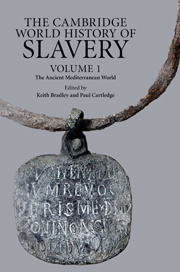Book contents
- Frontmatter
- Contents
- Series editors' introduction
- List of figures
- Acknowledgements
- Introduction
- 1 Slavery in the ancient Near East
- 2 Slaves in Greek literary culture
- 3 Classical Athens
- 4 The Helots: a contemporary review
- 5 Slavery and economy in the Greek world
- 6 The slave supply in classical Greece
- 7 Slavery and the Greek family
- 8 Resistance among chattel slaves in the classical Greek world
- 9 Archaeology and Greek slavery
- 10 Slavery in the Hellenistic world
- 11 Slavery and Roman literary culture
- 12 Slavery in the Roman Republic
- 13 Slavery Under the Principate
- 14 The Roman slave supply
- 15 Slave labour and Roman society
- 16 Slavery and the Roman family
- 17 Resisting slavery at Rome
- 18 Slavery and Roman material culture
- 19 Slavery and Roman law
- 20 Slavery and the Jews
- 21 Slavery and the rise of Christianity
- 22 Slavery in the late Roman world
- Bibliography
- General index
- Index of ancient passages cited
- Index of inscriptions and papyri
- Index of Jewish and Christian Literature Cited
14 - The Roman slave supply
Published online by Cambridge University Press: 28 September 2011
- Frontmatter
- Contents
- Series editors' introduction
- List of figures
- Acknowledgements
- Introduction
- 1 Slavery in the ancient Near East
- 2 Slaves in Greek literary culture
- 3 Classical Athens
- 4 The Helots: a contemporary review
- 5 Slavery and economy in the Greek world
- 6 The slave supply in classical Greece
- 7 Slavery and the Greek family
- 8 Resistance among chattel slaves in the classical Greek world
- 9 Archaeology and Greek slavery
- 10 Slavery in the Hellenistic world
- 11 Slavery and Roman literary culture
- 12 Slavery in the Roman Republic
- 13 Slavery Under the Principate
- 14 The Roman slave supply
- 15 Slave labour and Roman society
- 16 Slavery and the Roman family
- 17 Resisting slavery at Rome
- 18 Slavery and Roman material culture
- 19 Slavery and Roman law
- 20 Slavery and the Jews
- 21 Slavery and the rise of Christianity
- 22 Slavery in the late Roman world
- Bibliography
- General index
- Index of ancient passages cited
- Index of inscriptions and papyri
- Index of Jewish and Christian Literature Cited
Summary
PROBLEMS AND METHODS
Any reconstruction of the Roman slave supply depends on two variables: the total number of slaves, and the relative contribution of particular sources of slaves to overall supply. Owing to the nature of the record, these issues are at best only dimly perceptible. A simple comparison with the history of US slavery highlights the severity of this predicament: decadal census counts not only record the number and distribution of slaves but also permit us to calculate rates of natural reproduction and even to assess the patterns of the domestic slave trade. This body of data gives us a good idea of the scale and development of the underlying slave system. In the study of the world history of slavery, by contrast, an evidentiary basis of this kind is the exception, while uncertainty and guesswork are the norm. Roman slavery firmly belongs in the latter category: hardly any genuine statistics are available, and historians face two similarly unpalatable options. Thus, we may decide to eschew speculative quantification altogether and focus on what our sources readily provide – that is, qualitative impressions of the prevalence of slave-ownership and the provenance of slaves. This humanistic approach allows us to draw a rich canvas of slaveholdings large and small, and of a variety of sources of supply from capture in war all the way to voluntary self-enslavement. What it cannot do is to give us even a remotely reliable notion of the representative value of scattered references.
- Type
- Chapter
- Information
- The Cambridge World History of Slavery , pp. 287 - 310Publisher: Cambridge University PressPrint publication year: 2011
- 53
- Cited by

